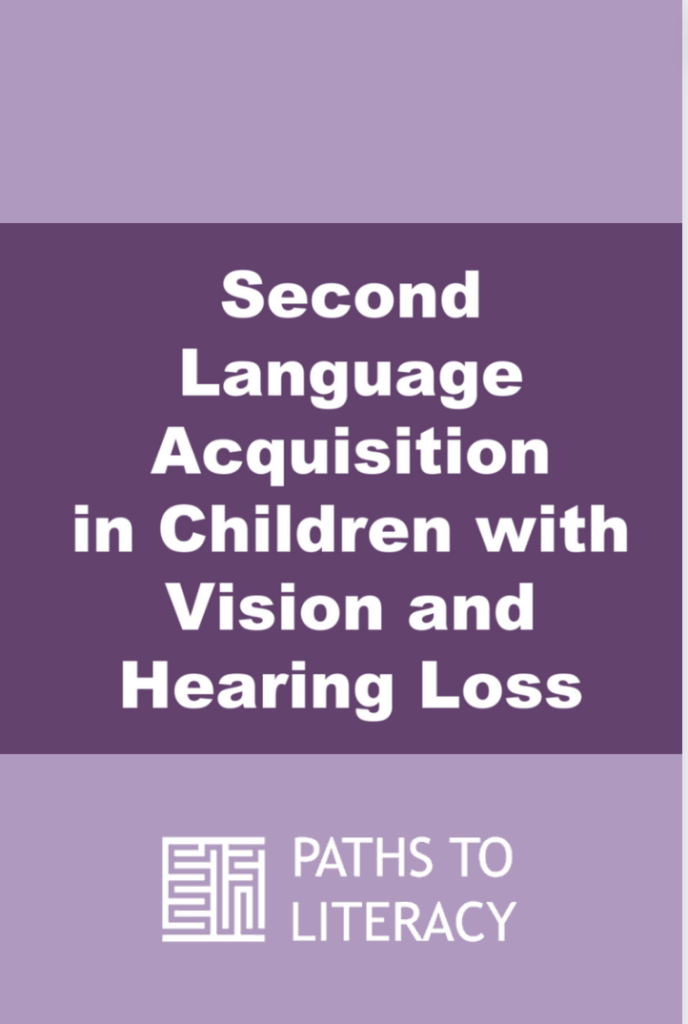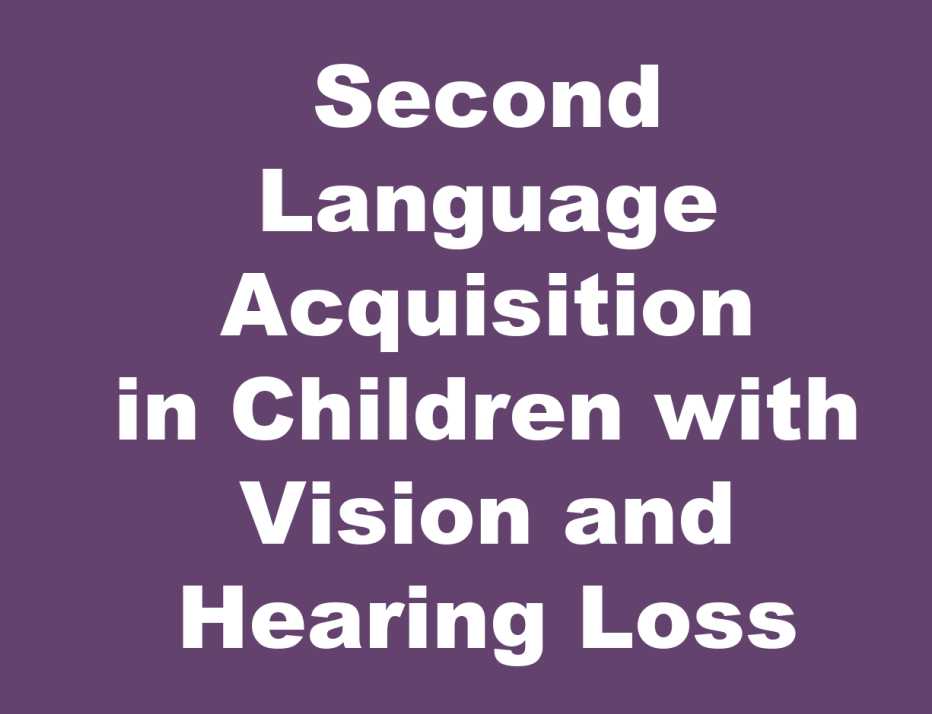By Maria L. Muñoz, M.A., CCC-SLP, TSBVI
First Language Acquisition
Babies are born with the ability to distinguish speech from other sounds they hear, even though they do not understand what it means. By the time children reach school age, they are speaking in complex sentences, having conversations, and understanding most of what they hear. How does the development of language occur?
Children’s brains are designed to help them learn language. From the time they are born, their brains register and process the sounds they hear. As a child’s brain, thinking skills, and motor systems develop, so does his/her understanding and use of language to communicate. Underlying language development is the ability to think about the world, and explore it with vision, hearing, smell, touch, etc. As a child begins to make sense of the world through exploration, language is attached to those experiences. Language develops gradually, from single words at about twelve months to complex sentences at five years, and from simple concepts (juice, shoes) to those that are more abstract (frustrated, addition). School-age children continue to learn and use increasingly complex and abstract language.
Because early language develops through sensory exploration and understanding of the world, language development for a child with a visual impairment or deafblindness will be effected by the nature and severity of the sensory impairments, and by other factors such as motor and cognitive skills. Some children with mild to moderate vision and hearing losses can be taught to compensate for limited visual and auditory information. They do this by using their other senses, thinking skills, and hands-on experiences to learn the meanings associated with words and sentences.
Second Language Acquisition
The development of a second language can occur in different ways. For example, a child may be exposed, from birth, to two languages at the same time; or a high school student might take a foreign language elective. I want to talk specifically about children who learn a language other than English at home, then begin to learn English when they enter school. Depending on the parents’ requests and services offered by the local district, these children may be placed in an English speaking classroom, an English as a Second Language (ESL) classroom, or a Bilingual Education classroom. It is important to note that a child’s classroom placement will have an impact on the development of both first and second languages. Bilingual education classes foster development of skills in English and the child’s first language. ESL classes only support skill development in English, a strategy that may be associated with slower acquisition of abstract language.
In general, these children enter school with proficiency in their native languages, which they then use as natural foundations for learning English. The process of acquiring English is gradual and follows a pattern of development similar to first language acquisition. For example, simple sentences are produced before complex ones. Children make errors in English that reflect the linguistic rules of their first language. For example, a Spanish speaking child may say, “I want the ball green,” because in Spanish speech, adjectives are spoken after nouns. Conversational skills are acquired (in about 2 years) before the abstract language required in a classroom is fully developed (in 5 to 7 years). These children still learn language best through exposure and experiences.
Second language acquisition, however, often occurs during classroom activities where specific, targeted English skills are being taught, rather than through the hands-on experiences typical of first language acquisition. Children are challenged to learn English quickly, while keeping up with the new concepts introduced in their classes every day. They have little time to learn basic English before it must be understood and used in highly abstract and decontextualized academic activities.
Visual and Auditory Impairment and Second Language Acquisition
Generally, it has been assumed that if a child’s first language develops normally, the second language will also develop normally. Why might this assumption NOT be true for children with visual impairments or deafblindness?
Many professionals, including myself, have observed that verbal children with visual impairments or deafblindness sometimes have great difficulty acquiring a second language. They also may have difficulty transitioning from bilingual education to English-only instruction. I think the differences between learning a first and second language come from the ways those two languages are acquired. As with all children, verbal children with visual impairments or deafblindness also learn their first language gradually, over many years. While the information they are getting from the environment is reduced, within the context of multiple, highly meaningful, multisensory experiences, other senses are used to support and compensate for limited visual and auditory information. A foundation of relatively normal language is built, upon which is added the complex language required in school.
Second language instruction in a classroom is by nature primarily visual and auditory. One language is used to teach another language, either through use of the first language or by simplified explanations of concepts in the second language. Because children are expected to use and understand abstract academic concepts in English almost immediately, they often don’t have time to develop complex language gradually. Children with visual impairments or deafblindness have difficulty compensating for the limited or distorted information received through their visual and auditory systems. They often cannot use touch, smell, taste, or movement to learn abstract concepts that are taught visually and auditorially. Therefore they must rely upon prior knowledge to understand what they are hearing and seeing. They can quickly and easily miss or misunderstand the concepts being taught.
Here is an example of how a student with deafblindness might have difficulty with second language acquisition. Juan, a Spanish-speaking student with a visual and auditory impairment, is in a class that’s beginning a study of oceans. The teacher shows a slide of the beach. (Juan sees a light and dark blur, but doesn’t recognize the picture.) The teacher says, “We are going to study oceans.” (Juan hears “oin.” Due to his hearing loss, he can’t hear /s/ or /sh/. He’s not sure what an “oin” is, and can’t see the slide well enough to figure it out.) Next, the teacher shows a slide of a fish and says, “We are going to study saltwater fish.” (Juan doesn’t know what a “altwatei” is and, again, can’t see the picture. With his limited English proficiency and hearing impairment, he doesn’t realize that two different words were spoken.) The teacher then asks the class to write a short paragraph about oceans. (Juan looks around and sees the other children writing, but is confused and does not understand the topic.)
In this example, Juan isn’t learning the English vocabulary because he cannot hear it clearly. He’s unable to fill in the auditory gaps with pictures because he cannot see them. Reduced auditory and visual input prevents Juan from recognizing the topic, and he doesn’t realize that the class is discussing familiar things; “mar” (sea) and “pez” (fish). Language learned in this context is very different from learning about oceans by going to the beach, playing in the sand and waves, smelling the salt air, and feeling fish brush against a leg. Juan’s ability to learn English is limited by the highly visual and auditory demands that are emphasized in his classroom setting.
A Few Suggestions for Encouraging Second Language Learning
- Consistently implement modifications and devices used to improve hearing and vision, such as hearing aids and glasses.
- Whenever possible, teach children through hands-on, multisensory activities that will help them learn experientially as well as linguistically.
- Use a child’s native language to support understanding of the second language.
- Help children understand the relationships between new concepts that are being taught and their familiar experiences.
- Children may require specific training in their second language, to discriminate between speech sounds and to identify word boundaries. These are critical skills for the development of reading and writing.
- Periodically check a child’s notes and ask questions to verify concept comprehension, making sure that visual and auditory information is interpreted accurately.
Resources
Guinan, H. (1997). ESL for students with visual impairments. Journal of Visual Impairment and Blindness, 91(6), 555-563.
Munoz, M. L. (1998). Language Assessment and Intervention with Children who have Visual Impairments: A guide for speech-language pathologists. Austin, TX: Texas School for the Blind and Visually Impaired.
Snyder, T. (1972). Teaching English as a second language to blind people. New Outlook for the Blind, 66(6), 161-166.
Williams, C. B. (1991). Teaching Hispanic deaf students: Lessons from Luis. Perspectives in Education and Deafness, 10(2), 2-5.
This article was originally published by Texas School for the Blind and Visually Impaired (Spring 2000 issue of See/Hear ) and is reprinted here with permission.





